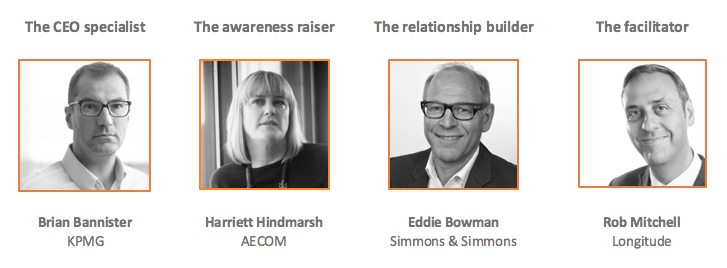Thought leadership reinvented: Trends in thought leadership for 2018
Guest post by Kim Barnes, session moderator
The battle for attention in the C-suite is tough, so how do brands break through the noise in 2018? Our latest thought leadership event brought together a panel of experts to help answer that question, and their experiences were illuminating.
The panel

Stick to your guns
Brian Bannister, global head of communications at KPMG, told us how his team has driven the firm’s successful CEO Outlook since its inception three years ago.
Drawing out data, stories and angles relevant to individual audiences, and packaging them for different formats, ensures that each annual report has a long shelf life. And it’s crucial to stay focused – even if others seem ready to move on.
“What’s been really successful about the project is that we’ve been absolutely ruthless in sticking to the formula. Year one, we tested the hypothesis and it worked. Year two, we had a whole tribe of people from around the world coming and asking to be added in – in different sectors, different geographies, going down the value chain in terms of company size. But we stuck to the formula.”
Start conversations
At AECOM, corporate VP, global marketing and communications Harriett Hindmarsh has a different challenge. The global multidisciplinary company has annual revenues of £20 billion and employs 100 thousand people – but it isn’t a household name.
The company is tackling that with thought leadership that focuses on its clients’ issues. “We decided to use thought leadership in a way that would push the understanding of what companies like us can do for the clients we deal with,” said Hindmarsh at our event. “We’re essentially trying to change not just opinions of what our company does, but also what our industry does. We’ve worked with FT Longitude to serve clients across the globe and understand their issues.”
The AECOM marketing team launched its first research-based piece in style at the World Economic Forum in Davos earlier this year, and generated 30,000 website hits in the first week.
“It was a bit of a leap of faith – we had never gone to Davos before,” said Hindmarsh. Three of us went this year – we tripled our investment, and we took this report – and it actually worked really well. I think it’s because of the good research we did. Our report hit all the themes around infrastructure, and it enabled us to have these conversations.”
Get people on board
Eddie Bowman’s marketing career took in the global consultancy EY before he became marketing and business development director at law firm Simmons & Simmons. And he told us that whatever the size of your organization, the key is to get internal stakeholders on board early.
“If you can’t get them thinking it’s a good idea, you’re just going to be having fun, but not delivering,” said Bowman. “You need to identify a smallish number of leaders in the business – partners who want to do it from the beginning, and are prepared to fight for you internally, and take you to the market. Those individuals need to be with you as you develop a hypothesis behind the thought leadership you’re going to create.
“Then you should make it really easy for your people to take it to the market,” he added. “Whatever it takes to serve up the insights and the information, in a way that makes people comfortable talking about it within their internal environment, or with their key clients.”
Bowman also emphasised the importance of credibility. “You need to build relationships with these people,” he said. “You need to have some personal credibility – they need to believe that you’re capable of delivering for them.”
Hindmarsh agreed. “It’s how it helps our people win work,” she said. “And if you can tie it back to this pursuit, then they buy into it, and you actually get the traction. You do need a few people behind you, but if you can’t prove how it improves the bottom line, you’ve lost them.”
Get a strong point of view
FT Longitude CEO Rob Mitchell told us how his team helps clients – many of which are trying to come up with great content on similar topical themes, such as cyber risk and AI.
“First, I think it’s having that company lens on what you’re doing,” he said. “Every company has its own personality, its own perspective, its own strategic goals. If you can apply that lens to a theme like cyber or AI, then you can create some clear water, and you can differentiate yourself from your competitors.
“For me, it’s about engaging the leadership, because they will have a point of view. They may need some help shaping and articulating it, but having that point of view is a starting point, and that ensures that you are not doing something similar to other companies.”
Ultimately, good ideas rule
Whatever their circumstances, the members of our panel agreed that it is crucial to find new ideas that stand up.
This means asking the right questions. “Good thought leadership is heretical”, said Brian Bannister. “It has to challenge the conventional wisdom.” From our audience, Euan Davis, who runs the thought leadership team at Cognizant, agreed, saying that good material should make him nervous.
Rob Mitchell added: “For me, thought leadership has to be about pushing the conversation forward and breaking new ground. And if you’re not doing that, then it’s ‘me too’ content – which by definition isn’t thought leadership. It ought to influence or change behaviour, because that’s ultimately what you’re trying to do with it.”

Kim Barnes, session moderator
Kim is a communications consultant, specialising in presentation and media coaching, story development and facilitation. She works with a broad range of corporate, public sector and not-for-profit clients. Previously, she was a TV reporter, working for the BBC, ITN, UK regional broadcasters and Associated Press Television News.
Watch video highlights from the event here:
We’ll be sharing more detailed insights from our expert panel here on the blog soon. If in the meantime you’d like to find out more about how to use innovative research and content-led campaigns to achieve competitive advantage, get in touch with our team.






 Back
Back

 Book a meeting
Book a meeting
 Book a meeting
Book a meeting

